Overview
We strive to care for the “whole person” by offering comprehensive and collaborative care that addresses the multiple, complex, lifelong and potentially disabling aspects of Marfan Syndrome and related conditions. Specialists at the Massachusetts General Hospital’s Marfan Syndrome and Related Conditions Program provide care for the symptoms that patients with these conditions experience.
The program’s cornerstones of care are patient education and shared decision-making. Patients and their families are encouraged to be partners with the treatment team and to be involved in every decision along the way.
Collaborative Care
The collaborative environment in the Marfan Syndrome and Related Conditions Program fosters a focused approach to a patient’s set of related diagnoses over their entire lifespan. We have assembled a specialized team that includes:
- Cardiac surgeons
- Cardiologists
- Endocrinologists
- Geneticists and genetic counselors
- Ophthalmologists
- Orthopedic surgeons
- Pain medicine specialists
- Podiatrists
- Pulmonologists
- Spine surgeons
- Vascular surgeons
Treatment Plan
The team uses imaging studies, past medical history and careful consideration of the patient’s relevant anatomy to help determine a course of optimal management. The recommended treatment plan is then shared with the patient, family and referring physician.
Given the breadth of resources at Mass General, our patients have access to additional medical and sub-specialty services for their related diagnoses. Support services, including medical interpreters and social services, are available to our patients as needed.
The program's multidisciplinary approach enhances the quality of care by fostering close communication among the patient’s treatment team. Team conferences and electronic medical records help facilitate collaboration among specialists, resulting in a well-integrated and consistent treatment plan that achieves the best outcomes possible.
About Marfans Syndrome
Marfan syndrome is a condition related to a defect in the gene encoding a protein called fibrillin-1, which is a building block of the fibers called elastin that give strength to the aorta and other tissues in the body. This mutation leads to dysregulation of a protein called transforming growth factor beta (TGF-β), with excess TGF-β signaling promoting continued tissue abnormalities. In the aorta, this can weaken the vessel wall and lead to the formation of an aortic aneurysm, with risk of aortic tearing or dissection. It is an autosomal dominant condition, meaning that the abnormal gene has a 50% chance of getting passed on to each offspring. However, a person might be the first one in their family to be affected.
Significant manifestations include:
- Aneurysmal enlargement of the aortic root
- Cardiomyopathy
- Chest wall deformities
- Ectopia lentis or displacement of the eye's crystalline lens
- Glaucoma
- High myopia
- High risk of aortic tear or dissection
- Loose ligaments causing joint hypermobility
- Lung disease, collapsed lung (pneumothorax)
- Mitral valve prolapse and regurgitation
- Ophthalmologic
- Osteoporosis
- Pes planus or flat foot
- Retinal detachment
- Scoliosis
- Skeletal
Related Conditions
MASS Phenotype
A condition related to a mutation in fibrillin-1 similar to Marfan Syndrome; MASS stands for the Mitral valve, myopia, Aorta, Skin and Skeletal features of the disorder.
Significant manifestations include:
- Aortic root ectasia or dilation, which usually does not progress to worsening enlargement or dissection
- Chest wall deformity
- Joint hypermobility
- Mitral valve prolapse, in which the valve leaflets are "floppy" and don't close tightly
- Myopia, or nearsightedness
- Scoliosis
- Striae, or stretch marks
Loeys-Dietz Syndrome (types 1-5)
A condition related to a genetic mutation in one of five genes that encode for the receptors and other molecules in the TGF-β pathway.
Significant manifestations include:
- Arterial tortuosity, or twisted or winding arteries
- Atrial septal defect, or a hole in the wall separating the top two chambers of the heart
- Bicuspid aortic valve
- Bowel rupture
- Bruises easily
- Cleft palate
- Club feet
- Gastrointestinal
- Hypertelorism, or wide-set eyes
- Instability or abnormality of the cervical spine
- Osteoporosis
- Patent ductus arteriosis
- Reproductive
- Soft, translucent skin
- Splenic rupture
- Uterine rupture during pregnancy
Vascular Type Ehlers Danlos Syndrome
One of several different types of Ehlers-Danlos syndrome, all related to defects in a type of protein called collagen.
Significant manifestations seen with the vascular form:
- Increased risk of intestinal rupture
- Uterine rupture during pregnancy
- Vascular rupture
Heritable Thoracic Aortic Disease (HTAD)
A thoracic aortic disease caused by mutation of a gene that confers risk for familial thoracic aortic aneurysms and aortic dissections (FTAAD). Approximately 20% of those with FTAAD, a “non-syndromic” condition, where individuals do not have systemic features of conditions such as Marfan syndrome, vascular Type Ehlers Danlos syndrome, or Loeys-Dietz syndrome, are estimated have a family history of TAAD (Thoracic Aortic Aneurysm and Dissection). HTAD is mostly known to be inherited in an autosomal dominant manner, and many causative genes have been identified.
Management & Treatment
Patients with Marfan Syndrome who are diagnosed and managed appropriately can expect to lead relatively normal lives, but lifelong oversight of the disease is required, and above all else, the aorta must be managed appropriately.
Patients need to have control of their blood pressure throughout their lives to avoid hypertension (high blood pressure) and limit the stress on the weakened wall of the aorta. Beta-blockers and angiotensin receptor blockers are the typical medications used to decrease the stress on the aorta by lowering blood pressure and heart rate. To optimally monitor blood pressure, we typically recommend that patients purchase an automatic blood pressure cuff to use at home on a regular basis.
Patients also undergo serial imaging studies to look for changes in the size of the involved portions of the aorta. Most of the time, the imaging studies are either a special type of contrast-enhanced CT scan, known as CT angiogram (or CTA), or a gadolinium-enhanced MRI, known as an MR angiogram (or MRA).
Other cardiac abnormalities such as problems with heart valves are followed with serial exams and echocardiography. Ocular and skeletal manifestations are managed with dedicated follow-up with the appropriate specialists. Our genetics team can be involved at diagnosis as well as in assessment of at-risk family members and pregnancy discussions.
The initial medical evaluation of a patient includes:
- A full exam and cardiovascular assessment
- Determination of whether intervention is necessary
- If intervention is necessary, determining which procedure is most appropriate for the patient’s specific condition
- Possible evaluation by the genetics team within the clinic
Imaging Techniques
Our specialists may use one or more imaging techniques to fully reveal the cardiac and aortic anatomy, including:
- Contrast angiography
- CT scans (computed tomography)
- MRA (magnetic resonance angiography)
- MRI (magnetic resonance imaging)
- TTE (Transthoracic echocardiography) and TEE (transesophageal echocardiography)
Innovative Treatment Strategies
In addition to standard therapies, specialists offer innovative strategies for managing Marfan syndrome and related conditions selectively, including:
Surgical Repair
Surgical repair of thoracic aortic aneurysms is usually carried out electively when the aneurysm is large enough in size to carry a significant risk of rupture or dissection, or when aneurysms cause symptoms or aortic valve dysfunction. Aneurysms of smaller size are usually managed medically with blood pressure control and close serial follow-up imaging.
While endovascular stent graft repair is offered for a variety of aortic conditions, the Professional Advisory Board of The Marfan Foundation is in agreement with the "Expert Consensus Document on the Treatment of Descending Thoracic Aortic Disease Using Endo-Vascular Stent-Grafts" (Ann Thorac Surg 2008;85:S1-41) and the American Heart Association (AHA) guidelines entitled “Surgical Management of Descending Thoracic Aortic Disease: Open and Endovascular Approaches” (Circulation 2010; 121:1544–79), which indicate that stent-grafts should not be used for patients with Marfan syndrome and related connective tissue disorders.
The overarching goal of the management of these conditions involves elective operation; however, emergency aortic surgery is occasionally needed for acute Type A aortic dissection, which involves the ascending aorta/aortic root (the very beginning part of the aorta just above the heart).
An aortic dissection is a life-threatening condition which occurs when the innermost lining of a weakened aortic wall tears, allowing blood from within the aorta to enter the tear and separate the layers of the artery, often propagating down the length of the aorta.
Aortic dissections that involve the ascending thoracic aorta are at high risk of aortic rupture, which can be fatal, and the early death rate is about one percent per hour. Therefore, the rapid diagnosis and treatment of this condition is critical. Type B aortic dissections involve the descending or more distant parts of the aorta, further from the heart, and are most often managed without surgery. They do require intensive care in a tertiary medical center. Mass General is a tertiary referral center with round-the-clock capabilities, with the goal of rapid diagnosis, care coordination, expert management and expedited surgical treatment.
Genetic Evaluation
Our genetics team offers consultation and follow up when our staff or a referring clinician suspect an underlying genetic cause. Genetic testing may include patient and family evaluation, blood testing, genetic counseling, and patient and family education.
Mark Lindsay, MD, PhD, is the cardiac geneticist with this program. His extensive experience with Marfan syndrome and related conditions is an invaluable resource for our physicians across all disciplines at Massachusetts General Hospital.
His research concentrates on the genetic etiology and pathophysiology of human vascular disease, focusing on genetic and epigenetic mechanisms of vascular aneurysms and dissections.
He is a member of the staff of the Cardiovascular Research Center at Mass General and the cardiology faculty of both Mass General and the Massachusetts General Hospital for Children.



